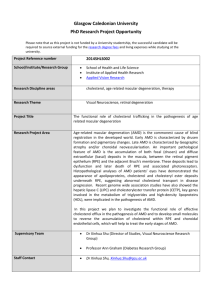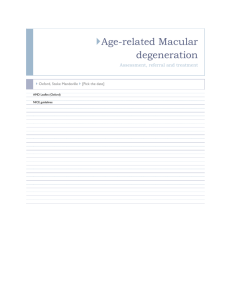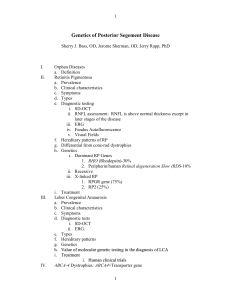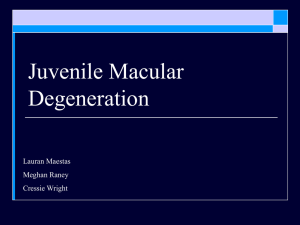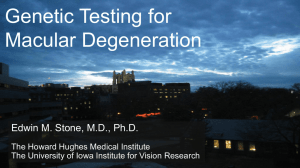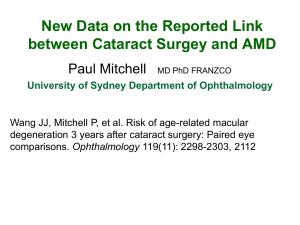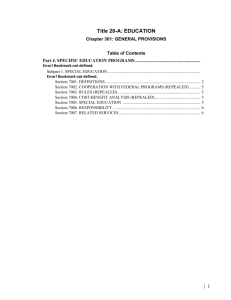Understanding of Age-Related Macular Degeneration Diagnosis
advertisement
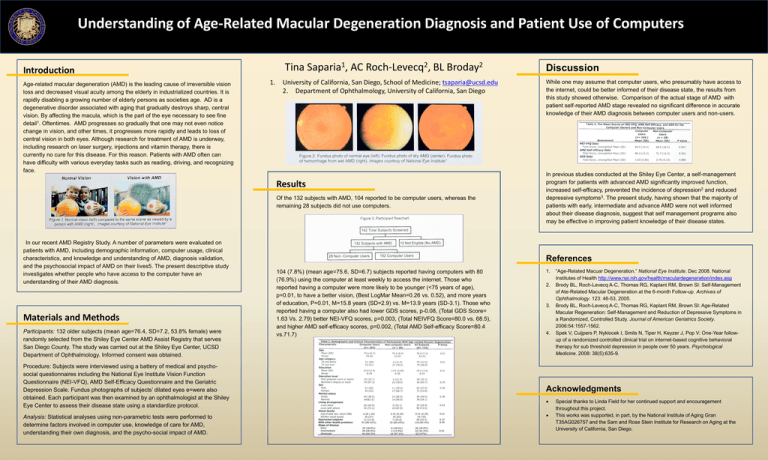
Understanding of Age-Related Macular Degeneration Diagnosis and Patient Use of Computers Tina Saparia1, AC Roch-Levecq2, BL Broday2 Introduction Age-related macular degeneration (AMD) is the leading cause of irreversible vision loss and decreased visual acuity among the elderly in industrialized countries. It is rapidly disabling a growing number of elderly persons as societies age. AD is a degenerative disorder associated with aging that gradually destroys sharp, central vision. By affecting the macula, which is the part of the eye necessary to see fine detail1. Oftentimes. AMD progresses so gradually that one may not even notice change in vision, and other times, it progresses more rapidly and leads to loss of central vision in both eyes. Although research for treatment of AMD is underway, including research on laser surgery, injections and vitamin therapy, there is currently no cure for this disease. For this reason. Patients with AMD often can have difficulty with various everyday tasks such as reading, driving, and recognizing face. 1. University of California, San Diego, School of Medicine; tsaparia@ucsd.edu 2. Department of Ophthalmology, University of California, San Diego Results Of the 132 subjects with AMD, 104 reported to be computer users, whereas the remaining 28 subjects did not use computers. In our recent AMD Registry Study. A number of parameters were evaluated on patients with AMD, including demographic information, computer usage, clinical characteristics, and knowledge and understanding of AMD, diagnosis validation, and the psychosocial impact of AMD on their lives5. The present descriptive study investigates whether people who have access to the computer have an understanding of their AMD diagnosis. Materials and Methods Participants: 132 older subjects (mean age=76.4, SD=7.2, 53.8% female) were randomly selected from the Shiley Eye Center AMD Assist Registry that serves San Diego County. The study was carried out at the Shiley Eye Center, UCSD Department of Ophthalmology. Informed consent was obtained. Procedure: Subjects were interviewed using a battery of medical and psychosocial questionnaires including the National Eye Institute Vision Function Questionnaire (NEI-VFQ), AMD Self-Efficacy Questionnaire and the Geriatric Depression Scale. Fundus photographs of subjects’ dilated eyes e=were also obtained. Each participant was then examined by an ophthalmologist at the Shiley Eye Center to assess their disease state using a standardize protocol. Analysis: Statistical analyses using non-parametric tests were performed to determine factors involved in computer use, knowledge of care for AMD, understanding their own diagnosis, and the psycho-social impact of AMD. Discussion While one may assume that computer users, who presumably have access to the internet, could be better informed of their disease state, the results from this study showed otherwise. Comparison of the actual stage of AMD with patient self-reported AMD stage revealed no significant difference in accurate knowledge of their AMD diagnosis between computer users and non-users. In previous studies conducted at the Shiley Eye Center, a self-management program for patients with advanced AMD significantly improved function, increased self-efficacy, prevented the incidence of depression2 and reduced depressive symptoms3. The present study, having shown that the majority of patients with early, intermediate and advance AMD were not well informed about their disease diagnosis, suggest that self management programs also may be effective in improving patient knowledge of their disease states. References 104 (7.8%) (mean age=75.6, SD=6.7) subjects reported having computers with 80 (76.9%) using the computer at least weekly to access the internet. Those who reported having a computer were more likely to be younger (<75 years of age), p=0.01, to have a better vision, (Best LogMar Mean=0.26 vs. 0.52), and more years of education, P=0.01, M=15.8 years (SD=2.9) vs. M=13.9 years (SD-3.1). Those who reported having a computer also had lower GDS scores, p-0.08, (Total GDS Score= 1.63 Vs. 2.79) better NEI-VFQ scores, p=0.003, (Total NEIVFQ Score=80.0 vs. 68.5), and higher AMD self-efficacy scores, p=0.002, (Total AMD Self-efficacy Score=80.4 vs.71.7) 1. 2. 3. 4. “Age-Related Macuar Degeneration.” National Eye Institute. Dec 2008. National Institutes of Health http://www.nei.nih.gov/health/maculardegeneration/index.asp Brody BL, Roch-Levecq A-C, Thomas RG, Kaplant RM, Brown SI: Self-Management of Ate-Related Macular Degeneration at the 6-month Follow-up. Archives of Ophthalmology. 123: 46-53, 2005. Brody BL, Roch-Levecq A-C, Thomas RG, Kaplant RM, Brown SI: Age-Related Macular Regeneration: Self-Management and Reduction of Depressive Symptoms in a Randomized, Controlled Study. Journal of American Geriatrics Society. 2006:54:1557-1562. Spek V, Cuijpers P, Nyklocek I, Smits N, Tiper H, Keyzer J, Pop V: One-Year followup of a randomized controlled clinical trial on internet-based cognitive behavioral therapy for sub threshold depression in people over 50 years. Psychological Medicine. 2008: 38(5):635-9. Acknowledgments Special thanks to Linda Field for her continued support and encouragement throughout this project. This works was supported, in part, by the National Institute of Aging Gran T35AG026757 and the Sam and Rose Stein Institute for Research on Aging at the University of California, San Diego.
